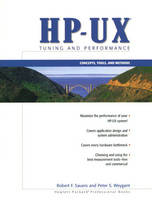
HP-UX Tuning and Performance
Prentice Hall (Verlag)
978-0-13-102716-9 (ISBN)
- Titel erscheint in neuer Auflage
- Artikel merken
PLEASE PROVIDE
10271-5 The "must-have" performance guide for every HP-UX administrator and developer! HP-UX Tuning and Performance is the first book to take the guesswork out of maximizing HP-UX performance! This book introduces a comprehensive, systematic performance management methodology that addresses every stage in the lifecycle of an HP-UX system. Two of Hewlett-Packard's leading HP-UX performance experts present specific metrics, symptoms, and solutions for each key element of an HP-UX system, including hardware, the OS platform, and application development. Coverage includes: *Identifying and addressing bottlenecks: CPU, memory, disk, network, and beyond. *Key tradeoffs impacting performance in both uniprocessor and SMP environments *Choosing the right performance metrics-and using them correctly *Compiler optimization and application profiling *Designing applications for maximum performance HP-UX Tuning and Performance introduces the best generic UNIX and HP-UX specific tools for performance management and demonstrates practical ways to instrument HP-UX systems so that your measurements truly represent real-world performance.Whether you're an HP-UX sys admin, net admin, developer, or capacity planner, it's your complete guide to getting all the performance you paid for!
I. PERFORMANCE MANAGEMENT METHODOLOGY.
1. Introduction to Performance Management.
Application Developer's Perspective. System Administrator's Perspective. Total System Resource Perspective. Rules of Performance Tuning.
2. Performance Management Tasks.
Workload Estimation. Benchmarking. Performance Characterization. Performance Prediction or Forecasting. Application Optimization. Capacity Planning. Performance Problem Resolution.
3. A Performance Management Methodology.
Assessment. Measurement. Interpretation and Analysis. Identifying Bottlenecks. Tuning or Upgrading.
4. Kernel Instrumentation and Performance Metrics.
Approaches to Measuring. Kernel Instrumentation and Measurement Interface. Performance Metrics Categories. Summary.
II. TOOLS AND METRICS.
5. Survey of Unix Performance Tools.
Multipurpose Diagnostic Tools. CPU Diagnostic Tools. Disk Diagnostic Tools. Memory Diagnostic Tools. Performance Characterization and Prediction Tools. Process Accounting Tools. Application Optimization Tools. Network Diagnostic Tools. and Later). Capacity Planning Tools.
6. Performance Tools Alphabetical Reference.
System V Tools. Berkeley Tools. HP-UX Tools. Other Tools. Headings in the Summary Chart. Tool Reference Tables.
III. PERFORMANCE BOTTLENECK ANALYSIS.
7. Hardware Performance Issues.
Terminology. Processor Instructions and Modules. Multi-Processing. Cache Memory for Instructions and Data. Physical Address Space. Virtual Address Space. PA-RISC Architectures. Summary Data.
8. CPU Bottlenecks.
Processes and Scheduling. Real-Time Scheduling. Time-Share Scheduling. Context Switches. SMP Scheduling Issues. Processor Affinity. Traps and Protection Violations. Global CPU Metrics. Typical Metric Values. Symptoms of a CPU Bottleneck. CPU Use and Performance Tools. Tuning CPU Bottlenecks.
9. Memory Bottlenecks.
Virtual Address Space. Types of Magic. fork() and vfork(). Dynamic Buffer Cache. Sticky Bit. Memory-Mapped Files and Semaphores. Shared Libraries. Paging, Swapping, and Deactivation. Memory Management Thresholds. Sizing Memory and the Swap Area. Memory Metrics. Types of Memory Management Bottlenecks. Expensive System Calls. Tuning Memory Bottlenecks. Memory-Related Tunable Parameters.
10. Disk Bottlenecks.
Review of Disk I/O Concepts. Logical Volume Manager Concepts. Disk Arrays. Shared-Bus Access to Disks. File Systems and the Kernel. File System Types. Disk Metrics. Types of Disk Bottlenecks. Expensive System Calls. Tuning Disk Bottlenecks. Database Issues. Disk Related Tunable Parameters.
IV. APPLICATION TUNING.
11. Compiler Optimization.
Compilers and Optimization. Optimization Levels. Compiling for a Target Architecture. Other Compiler and Linker Options. Why Does Optimization "Break" Applications? Debugging Optimization Problems. Options for Fortran and COBOL. Profile-Based Optimization. Porting Applications. Code to Demonstrate Optimization Effects.
12. Designing Applications for Performance.
Tips for Application Design. Shared versus Archive Libraries. Archive Libraries. Choosing an Inter-Process Communication (IPC) Mechanism. Instrumenting an Application for Performance Monitoring.
13. Application Profiling.
CXperf. gprof. Puma.
Index.
| Erscheint lt. Verlag | 2.8.1999 |
|---|---|
| Verlagsort | Upper Saddle River |
| Sprache | englisch |
| Maße | 179 x 235 mm |
| Gewicht | 528 g |
| Themenwelt | Informatik ► Betriebssysteme / Server ► Unix / Linux |
| ISBN-10 | 0-13-102716-6 / 0131027166 |
| ISBN-13 | 978-0-13-102716-9 / 9780131027169 |
| Zustand | Neuware |
| Haben Sie eine Frage zum Produkt? |
aus dem Bereich



